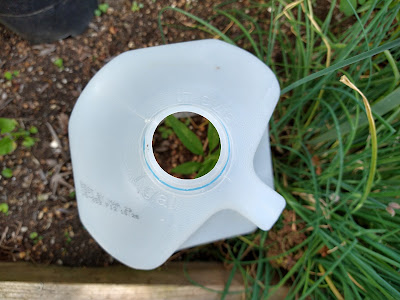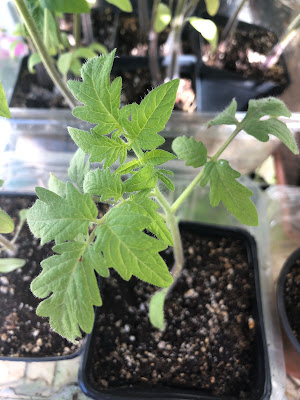
Wind chill expected to drop overnight lows to 32 degrees in Sacramento

|
|
A milk jug with the bottom cut off protects a little pepper plant
from frost damage. (Photo: Debbie Arrington)
|
Just when you (and I) thought it was safe to plant our tomatoes, we have an extra-late threat of frost – three weeks after our traditional frost date.
Tuesday’s overnight lows are expected to plunge into the mid 30s. With wind chill, it will feel like 32 degrees in Sacramento – and colder in the foothills.
According to the National Weather Service, storm systems later this week will drop snow as low as 3,500 feet on Wednesday night. And we may have more cold, rainy days this week than we had in all of March.
Following days in the 90s just last week, this cold spell will put on the brakes to rapid spring growth – or kill it all together.
So, what’s a poor tomato plant to do? Huddle up with some temporary protection.
Use a plastic milk or water jug as a mini hot house over a new transplant. Cut out the bottom and leave off the cap. This do-it-yourself “hot cap” will protect the transplant from wind chill and frost danger.

|
|
If your tomato plants aren't in the ground yet,
wait at least a few more days until the frost danger
is past. (Photo: Kathy Morrison)
|
In the afternoon, deep water tender plants; that extra moisture keeps the ground warm enough to avoid damage. Also, deep water citrus trees, which are now in bloom.
Another precaution: Make sure to mulch your veggies. Those wood chips or leaves act like a blanket over plant roots, keeping them moist and cozy.
Signs of frost damage are already prevalent in Sacramento gardens, due to some unseasonably cold nights in mid March. That chill killed new sprouts and browned transplants as well as burned tender growth on roses and other shrubs that were pushing out shoots.
When temperatures warm up reliably later this month, trim off the damaged foliage from shrubs. Frost-burned transplants may need to be replaced.
Then, it will be time to plant more tomatoes.
Comments
0 comments have been posted.Sacramento Digs Gardening to your inbox.
Sites We Like
Garden Checklist for week of July 21
Your garden needs you!
* Keep your vegetable garden watered, mulched and weeded. Water before 8 a.m. to reduce the chance of fungal infection and to conserve moisture.
* Feed vegetable plants bone meal, rock phosphate or other fertilizers high in phosphate to stimulate more blooms and fruiting. (But wait until daily high temperatures drop out of the 100s.)
* Don’t let tomatoes wilt or dry out completely. Give tomatoes a deep watering two to three times a week.
* Harvest vegetables promptly to encourage plants to produce more. Squash especially tends to grow rapidly in hot weather. Keep an eye on zucchini.
* Pinch back chrysanthemums for bushy plants and more flowers in September.
* Remove spent flowers from roses, daylilies and other bloomers as they finish flowering.
* Pinch off blooms from basil so the plant will grow more leaves.
* Cut back lavender after flowering to promote a second bloom.
* It's not too late to add a splash of color. Plant petunias, snapdragons, zinnias and marigolds.
* From seed, plant corn, pumpkins, radishes, winter squash and sunflowers.